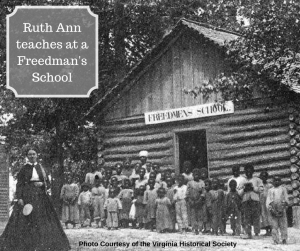As a writer of historical romance, I’m often asked questions about how I research my stories. I thought today, I’d start a blog series that would give you some insight into how real-life history inspired many of the scenes in A Love Restored.
First, let me give you a little background on the story. A Love Restored is based on my real-life romance with my husband, Mike. I just set the story in the past because I’m a HUGE history nerd. If you’re one of my faithful readers, I’m sure you can relate.
I am blessed to live in northern Virginia, an area rich in our nation’s history. I knew if I set my story in post-Civil War Loudoun County, where I’ve lived since 1972, I would have plenty of historical details to give the reader that would draw them into the period and setting of my story. I decided to use my own home town of Purcellville at the time the Washington & Ohio Railroad arrived in the “sleepy little hamlet” so that my hero, Benjamin Coulter could be a surveyor planning the railroad’s route.
Since the story is based on my life, it was a natural choice to make my heroine, Ruth Ann Sutton, a teacher as well. While researching the post-Civil War history of my town and the county as a whole, I wandered off track down a historical rabbit trail so to speak and began reading about the life of the freed slaves in the area and the Freedmen’s Schools to educate them.
The Bureau of Refugees, Freedmen, and Abandon Lands, commonly referred to as the The Freedmen’s Bureau, was established in 1865 to help provide for the hundreds of thousands of freed slaves in the aftermath of America’s Civil War.
While researching, I discovered that Fannie Wood, a white woman from Middleboro, Massachusetts, came to the area to teach in one of the newly authorized Freedmen’s Bureau schools in the nearby town of Warrenton. This was a common arrangement at the time. Many northern organizations, frequently organized by Quakers, funded Freedmen’s Bureau schools in the South and provided the teacher’s salary as well as their room and board with local families. The Richmond Times, an influential newspaper at the time, referred to such teachers as “pretty Yankee girls,” and “missionaries” in an effort to diminish their noble purpose.
But in Reconstruction Era Virginia, Miss Wood’s tenure would not be without opposition from those who did not want the freed slaves educated. A Warrenton newspaper, The True Index, printed the first paragraph of a threatening letter sent to Miss Wood:
“We the young men of this town think you are a disgrace to decent society and therefore wish you to leave this town before the first of March and if you don’t there will be violence used to make you comply to this request.”
At this point I knew that my heroine would now teach a Freedman’s School providing plenty of tension for my story. While Freedmen’s Schools existed in nearby Leesburg, Waterford and Lincoln, no school for African Americans existed in my town, Purcellville, until the 1890s. At this point I decided to change the name of Ruth Ann’s town to Catoctin Creek after the little stream that runs through Purcellville.
My research further discovered reports in The True Index that Wood had been “serenaded” by “songs and expressions not intended for ears polite.” Federal troops, used to enforce the Bureau’s efforts to educate the freed slaves, were sent to Warrenton to prevent any escalation of hostilities. This calmed the tension for a while but after the soldiers left, her classroom was pelted with stones. Union Lieutenant, William Augustus McNulty, who was the head of the Freedman’s Bureau for the Warrenton area, continued protecting Miss Wood. In fact, he and his wife, Abbie, eventually helped her teach the adult students in the evening.
Can you just imagine the sight of a white Federal officer teaching freed slaves in post-Civil War Virginia?
I knew immediately that I wanted to capture this scene in A Love Restored. When Benjamin discovers the threatening letters Ruth Ann had been receiving, letters she took great pains to hide from him, Benjamin seeks the aid of Federal officers assigned to protect the Freedmen’s Schools in the area. My secondary story line really came to life now birthing the character of Union Army Captain John Reynolds who would aid Benjamin in the protection of Ruth Ann and her students.
In A Love Restored, the danger escalates to a dramatic raid on the Freedmen’s School by hooded-vigilantes. Although inspired by many real-life accounts of violence against Freedmen’s Schools throughout the South, nothing of that magnitude happened in my county.
Thank you for joining me on this little excursion through one of history’s interesting paths. You never know what you might discover when following a rabbit trail. For me, I found the glue that tied so many smaller plot lines together as well as a way to add historical depth to my story.
This post first appeared on Connie’s History Classroom (July 10, 2018)
Your Turn: What interesting historical fact have you learned roaming the internet?


